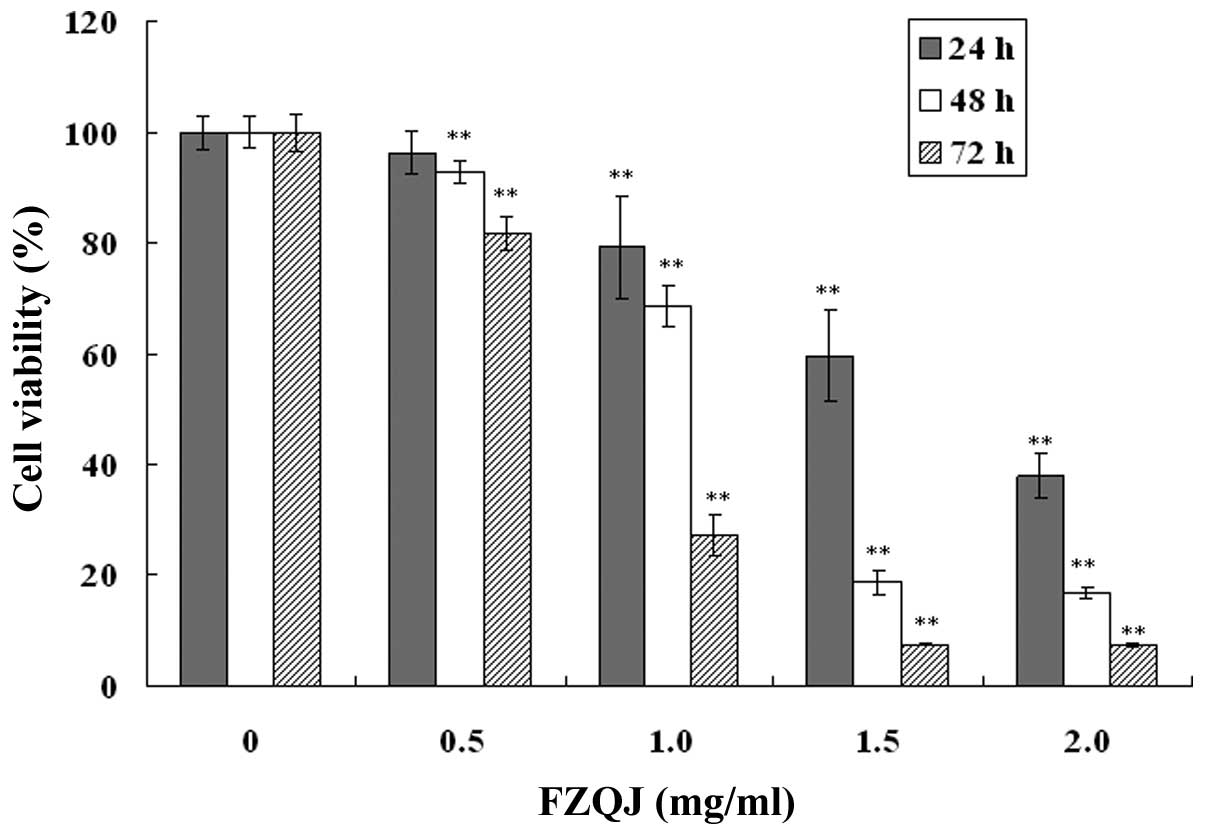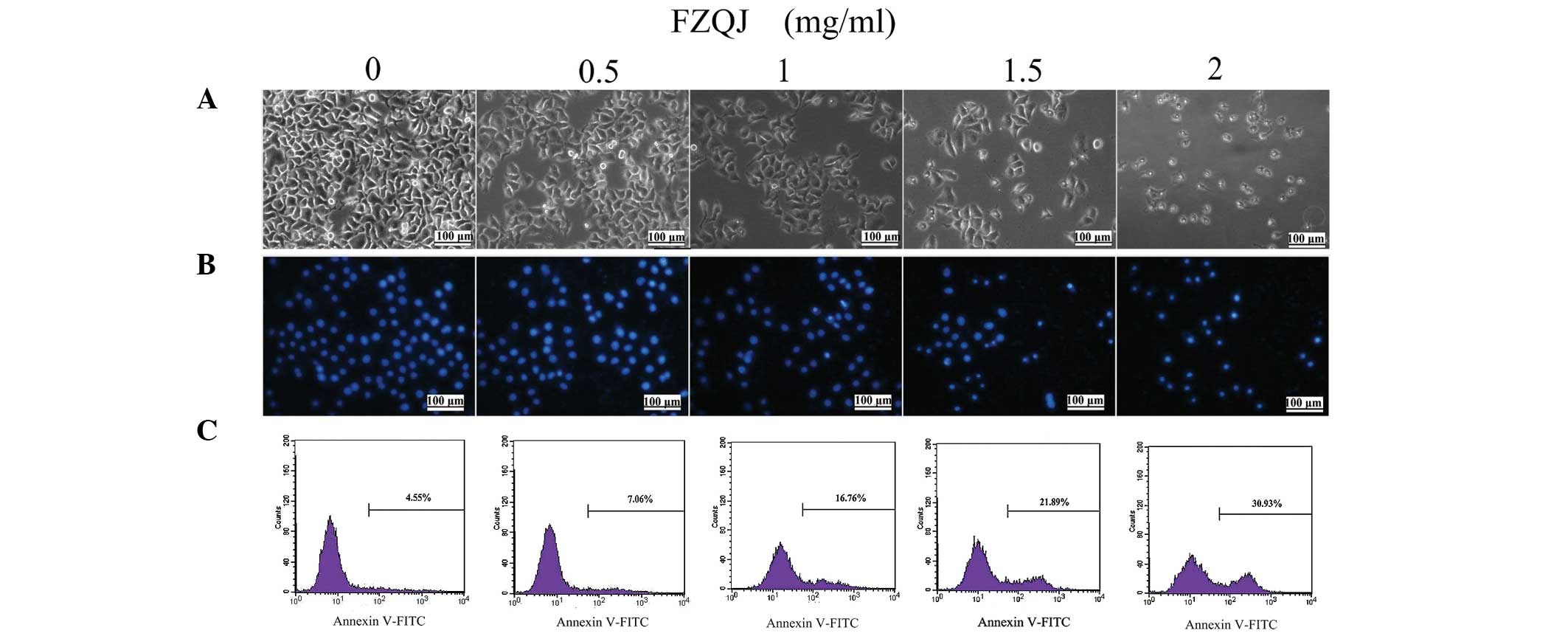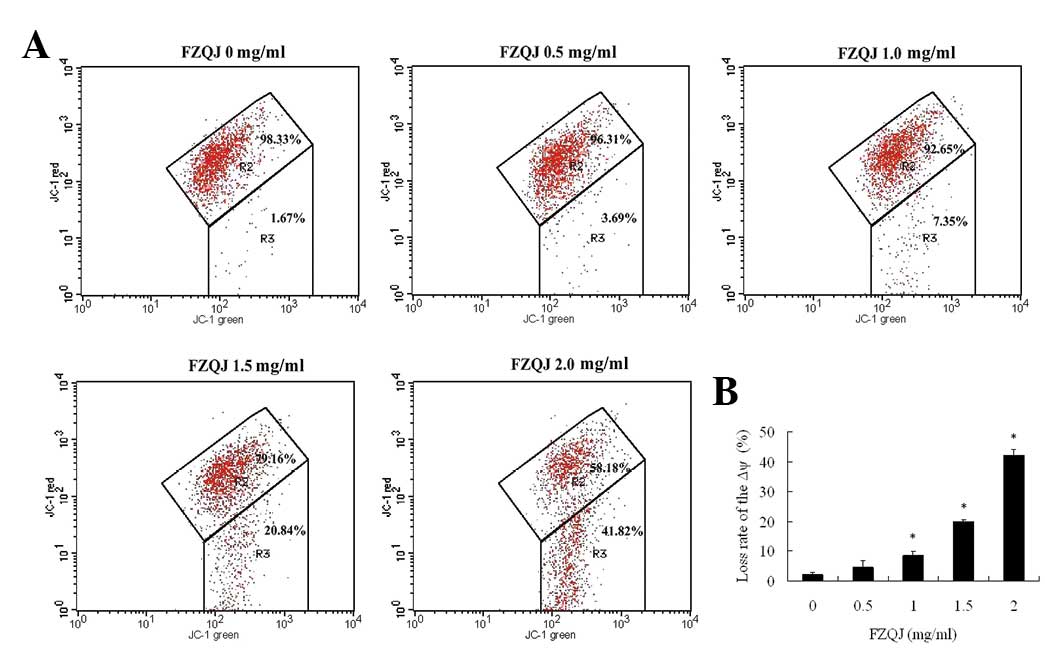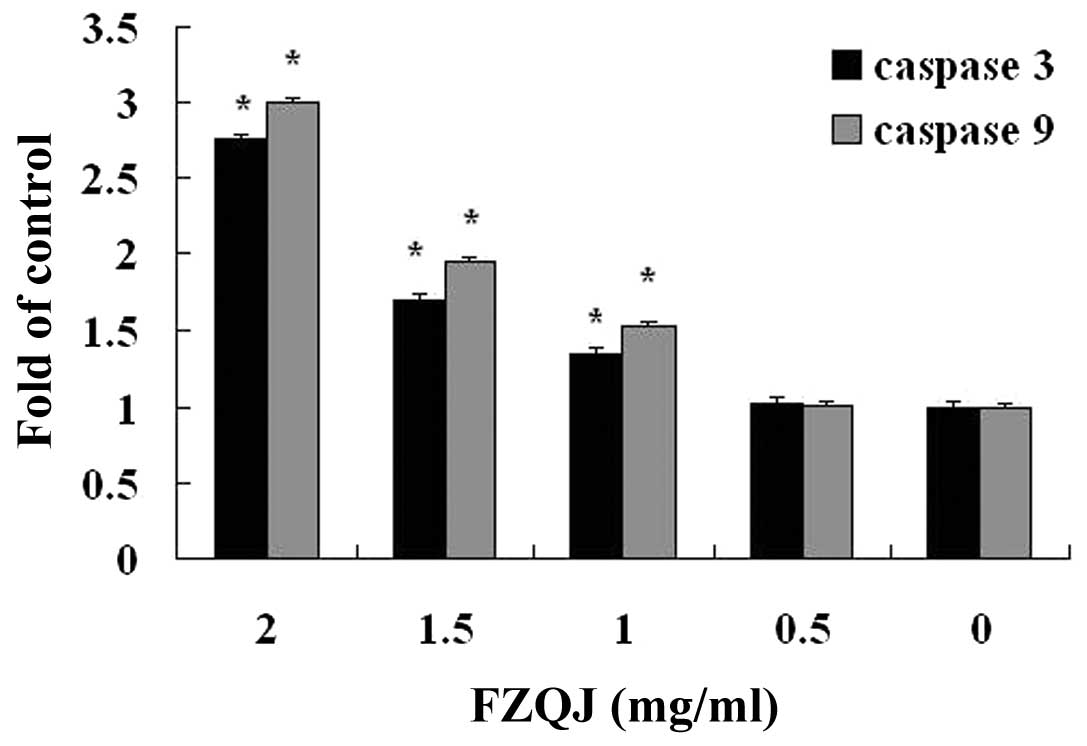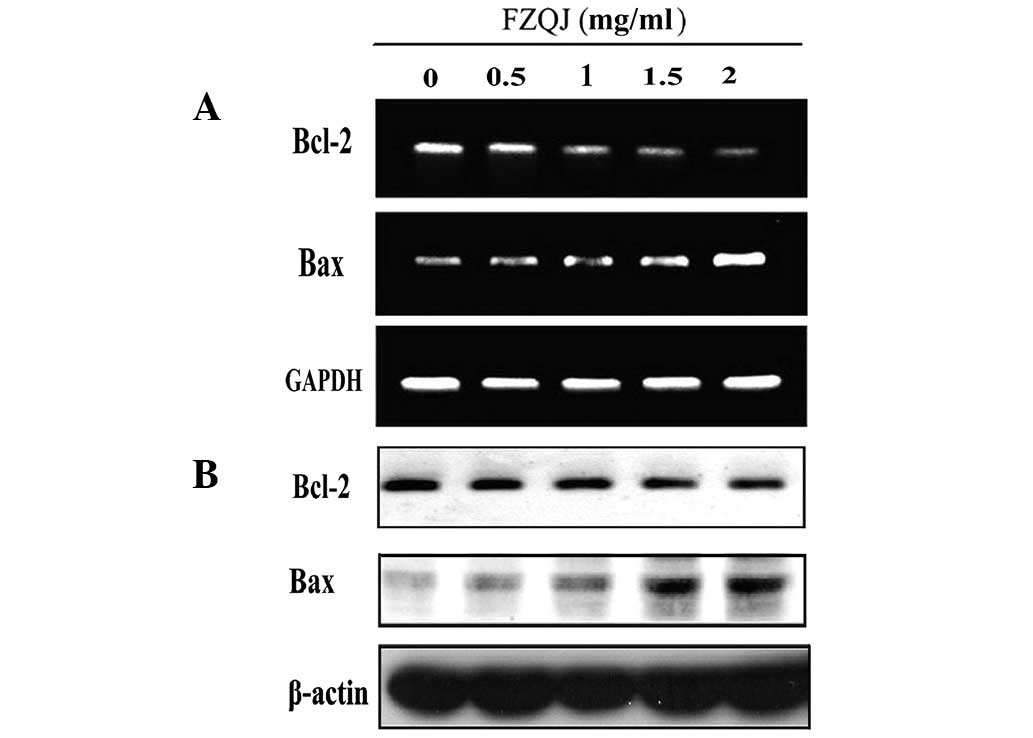|
1
|
Rampone B, Schiavone B, Martino A, Viviano
C and Confuorto G: Current management strategy of hepatocellular
carcinoma. World J Gastroenterol. 15:3210–3216. 2009. View Article : Google Scholar : PubMed/NCBI
|
|
2
|
Chung YH, Song IH, Song BC, Lee GC, Koh
MS, Yoon HK, Lee YS, Sung KB and Suh DJ: Combined therapy
consisting of intraarterial cisplatin infusion and systemic
interferon-alpha for hepatocellular carcinoma patients with major
portal vein thrombosis or distant metastasis. Cancer. 88:1986–1991.
2000. View Article : Google Scholar
|
|
3
|
Mazzaferro V, Regalia E, Doci R, Andreola
S, Pulvirenti A, Bozzetti F, Montalto F, Ammatuna M, Morabito A and
Gennari L: Liver transplantation for the treatment of small
hepatocellular carcinomas in patients with cirrhosis. N Engl J Med.
334:693–699. 1996. View Article : Google Scholar : PubMed/NCBI
|
|
4
|
Urruticoechea A, Alemany R, Balart J,
Villanueva A, Viñals F and Capellá G: Recent advances in cancer
therapy: an overview. Curr Pharm Des. 16:3–10. 2010. View Article : Google Scholar
|
|
5
|
Kang S and Min H: Ginseng, the ‘Immunity
Boost’: The Effects of Panax ginseng on Immune System. J Ginseng
Res. 36:354–368. 2012.
|
|
6
|
Choi J, Kim TH, Choi TY and Lee MS:
Ginseng for health care: a systematic review of randomized
controlled trials in Korean literature. PLoS One. 8:e599782013.
View Article : Google Scholar : PubMed/NCBI
|
|
7
|
Chang YH, Yang JS, Yang JL, Wu CL, Chang
SJ, Lu KW, Kuo CL, Hsia TC and Chung JG: Gandoderma lucidum extract
promotes immune responses in normal BALB/c mice in vivo. In Vivo.
23:755–759. 2009.PubMed/NCBI
|
|
8
|
Bao PP, Lu W, Cui Y, Zheng Y, Gu K, Chen
Z, Zheng W and Shu XO: Ginseng and Ganoderma lucidum use after
breast cancer diagnosis and quality of life: a report from the
Shanghai Breast Cancer Survival Study. PloS One. 7:e393432012.
View Article : Google Scholar : PubMed/NCBI
|
|
9
|
Shi Y, Wang CH and Gong XG:
Apoptosis-inducing effects of two anthraquinones from Hedyotis
diffusa WILLD. Biol Pharm Bull. 31:1075–1078. 2008. View Article : Google Scholar : PubMed/NCBI
|
|
10
|
Lin J, Wei L, Shen A, Cai Q, Xu W, Li H,
Zhan Y, Hong Z and Peng J: Hedyotis diffusa Willd extract
suppresses Sonic hedgehog signaling leading to the inhibition of
colorectal cancer angiogenesis. Int J Oncol. 42:651–656. 2013.
View Article : Google Scholar
|
|
11
|
Kim SH, Huang CY, Tsai CY, Lu SY, Chiu CC
and Fang K: The aqueous extract of Prunella vulgaris suppresses
cell invasion and migration in human liver cancer cells by
attenuating matrix metalloproteinases. Am J Chin Med. 40:643–656.
2012. View Article : Google Scholar : PubMed/NCBI
|
|
12
|
Chen XZ, Cao ZY, Chen TS, Zhang YQ, Liu
ZZ, Su YT, Liao LM and Du J: Water extract of Hedyotis
Diffusa Willd suppresses proliferation of human HepG2 cells and
potentiates the anticancer efficacy of low-dose 5-fluorouracil by
inhibiting the CDK2-E2F1 pathway. Oncol Rep. 28:742–748. 2012.
|
|
13
|
Cai Jing, Cao Zhiyun, Chen Liwu, Chen
Xuzheng, Du Jian and Liu Zhizhen: Traditional Chinese medicine for
treating tumor of digestive tract, strengthening body, resistance
and removing summer-heat. CN Patent 201010130786. Filed March 23,
2010; issued August 4, 2010.
|
|
14
|
Jeong SY and Seol DW: The role of
mitochondria in apoptosis. BMB Rep. 41:11–22. 2008. View Article : Google Scholar
|
|
15
|
Ghatan S, Larner S, Kinoshita Y, Hetman M,
Patel L, Xia Z, Youle RJ and Morrison RS: p38 MAP kinase mediates
bax translocation in nitric oxide-induced apoptosis in neurons. J
Cell Biol. 150:335–347. 2000. View Article : Google Scholar : PubMed/NCBI
|
|
16
|
Ernst E and Cassileth BR: The prevalence
of complementary/alternative medicine in cancer: a systematic
review. Cancer. 83:777–782. 1998. View Article : Google Scholar : PubMed/NCBI
|
|
17
|
Boon H, Brown JB, Gavin A, Kennard MA and
Stewart M: Breast cancer survivors’ perceptions of
complementary/alternative medicine (CAM): making the decision to
use or not to use. Qual Health Res. 9:639–653. 1999.
|
|
18
|
Konkimalla VB and Efferth T:
Evidence-based Chinese medicine for cancer therapy. J
Ethnopharmacol. 116:207–210. 2008. View Article : Google Scholar : PubMed/NCBI
|
|
19
|
Posadzki P, Watson LK and Ernst E: Adverse
effects of herbal medicines: an overview of systematic reviews.
Clin Med. 13:7–12. 2013. View Article : Google Scholar : PubMed/NCBI
|
|
20
|
Liu Z, Chen S, Cai J, Zhang E, Lan L,
Zheng J, Liao L, Yang X, Zhou C and Du J: Traditional Chinese
medicine syndrome-related herbal prescriptions in treatment of
malignant tumors. J Tradit Chin Med. 33:19–26. 2013. View Article : Google Scholar : PubMed/NCBI
|
|
21
|
Chen LW, Zheng CS and Du J: Study on
antitumor mechanism of Qingre xiaozheng drink by molecular docking
method. Chin J Clin Pharmacol Ther. 12:324–328. 2007.(In
Chinese).
|
|
22
|
Tian QE, De Li H, Yan M, Cai HL, Tan QY
and Zhang WY: Effects of Astragalus polysaccharides on
P-glycoprotein efflux pump function and protein expression in H22
hepatoma cells in vitro. BMC Complement Altern Med. 12:942012.
|
|
23
|
Ye MN, Chen HF, Zhou RJ and Liao MJ:
Effects of Astragalus polysaccharide on proliferation and
Akt phosphorylation of the basal-like breast cancer cell line.
Zhong Xi Yi Jie He Xue Bao. 9:1339–1346. 2011.(In Chinese).
|
|
24
|
Wang N, Li DY, Niu HY, Zhang Y, He P and
Wang JH: 2-hydroxy-3-methylanthraquinone from Hedyotis
diffusa Willd induces apoptosis in human leukemic U937 cells
through modulation of MAPK pathways. Arch Pharm Res. 36:752–758.
2013.
|
|
25
|
Liu Z, Liu M, Liu M and Li J:
Methylanthraquinone from Hedyotis diffusa WILLD induces
Ca(2+)-mediated apoptosis in human breast cancer cells. Toxicol In
Vitro. 24:142–147. 2010.
|
|
26
|
Wang JH, Shu LH, Yang LL, Zhang M and He
P: 2-Hydroxy-3-methylanthraquinone from Hedyotis diffusa
WILLD induces apoptosis via alteration of Fas/FasL and activation
of caspase-8 in human leukemic THP-1 cells. Arch Med Res.
42:577–583. 2011.
|
|
27
|
Pan K, Jiang Q, Liu G, Miao X and Zhong D:
Optimization extraction of Ganoderma lucidum polysaccharides
and its immunity and antioxidant activities. Int J Biol Macromol.
55:301–306. 2013.
|
|
28
|
Feng L, Au-Yeung W, Xu YH, Wang SS, Zhu Q
and Xiang P: Oleanolic acid from Prunella Vulgaris L induces
SPC-A-1 cell line apoptosis via regulation of Bax, Bad and Bcl-2
expression. Asian Pac J Cancer Prev. 12:403–408. 2011.
|
|
29
|
Wang J, Shan A, Liu T, Zhang C and Zhang
Z: In vitro immunomodulatory effects of an oleanolic acid-enriched
extract of Ligustrum lucidum fruit (Ligustrum lucidum
supercritical CO2 extract) on piglet immunocytes. Int
Immunopharmacol. 14:758–763. 2012. View Article : Google Scholar : PubMed/NCBI
|
|
30
|
Zhao G, Kan J, Li Z and Chen Z: Structural
features and immunological activity of a polysaccharide from
Dioscorea opposita Thunb roots. Carbohydr Polym. 61:125–131.
2005. View Article : Google Scholar
|
|
31
|
Hakem R, Hakem A, Duncan GS, et al:
Differential requirement for caspase 9 in apoptotic pathways in
vivo. Cell. 94:339–352. 1998. View Article : Google Scholar : PubMed/NCBI
|
|
32
|
Ferri KF and Kroemer G: Organelle-specific
initiation of cell death pathways. Nat Cell Biol. 3:E255–E263.
2001. View Article : Google Scholar : PubMed/NCBI
|
|
33
|
Hajnóczky G, Csordás G, Das S,
Garcia-Perez C, Saotome M, Sinha Roy S and Yi M: Mitochondrial
calcium signalling and cell death: approaches for assessing the
role of mitochondrial Ca2+ uptake in apoptosis. Cell
Calcium. 40:553–560. 2006.PubMed/NCBI
|
|
34
|
Zou H, Li Y, Liu X and Wang X: An APAF-1.
cytochrome cmultimeric complex is a functional apoptosome that
activates procaspase-9. J Biol Chem. 274:11549–11556. 1999.
View Article : Google Scholar : PubMed/NCBI
|
|
35
|
Acehan D, Jiang X, Morgan DG, Heuser JE,
Wang X and Akey CW: Three-dimensional structure of the apoptosome:
implications for assembly, procaspase-9 binding, and activation.
Mol Cell. 9:423–432. 2002. View Article : Google Scholar : PubMed/NCBI
|
|
36
|
Baliga B and Kumar S: Apaf-1/cytochrome c
apoptosome: an essential initiator of caspase activation or just a
sideshow? Cell Death Differ. 10:16–18. 2003. View Article : Google Scholar : PubMed/NCBI
|
|
37
|
Yu X, Wang L, Acehan D, Wang X and Akey
CW: Three-dimensional structure of a double apoptosome formed by
the Drosophila Apaf-1 related killer. J Mol Biol. 355:577–589.
2006. View Article : Google Scholar : PubMed/NCBI
|
|
38
|
Yin C, Knudson CM, Korsmeyer SJ and Van
Dyke T: Bax suppresses tumorigenesis and stimulates apoptosis in
vivo. Nature. 385:637–640. 1997. View Article : Google Scholar : PubMed/NCBI
|
|
39
|
Brenner B, Koppenhoefer U, Weinstock C,
Linderkamp O, Lang F and Gulbins E: Fas- or ceramide-induced
apoptosis is mediated by a Rac1-regulated activation of Jun
N-terminal kinase/p38 kinases and GADD153. J Biol Chem.
272:22173–22181. 1997. View Article : Google Scholar : PubMed/NCBI
|
|
40
|
Ichijo H, Nishida E, Irie K, ten Dijke P,
Saitoh M, Moriguchi T, Takagi M, Matsumoto K, Miyazono K and Gotoh
Y: Induction of apoptosis by ASK1, a mammalian MAPKKK that
activates SAPK/JNK and p38 signaling pathways. Science. 275:90–94.
1997. View Article : Google Scholar : PubMed/NCBI
|
|
41
|
Schwenger P, Bellosta P, Vietor I,
Basilico C, Skolnik EY and Vilcek J: Sodium salicylate induces
apoptosis via p38 mitogen-activated protein kinase but inhibits
tumor necrosis factor-induced c-Jun N-terminal
kinase/stress-activated protein kinase activation. Proc Natl Acad
Sci USA. 94:2869–2873. 1997. View Article : Google Scholar
|
|
42
|
Kornmann M, Ishiwata T, Kleeff J, Beger HG
and Korc M: Fas and Fas-ligand expression in human pancreatic
cancer. Ann Surg. 231:368–379. 2000. View Article : Google Scholar : PubMed/NCBI
|
|
43
|
Stoneley M, Chappell SA, Jopling CL,
Dickens M, MacFarlane M and Willis AE: c-Myc protein synthesis is
initiated from the internal ribosome entry segment during
apoptosis. Mol Cell Biol. 20:1162–1169. 2000. View Article : Google Scholar : PubMed/NCBI
|
|
44
|
Cuadrado A, Lafarga V, Cheung PC, Dolado
I, Llanos S, Cohen P and Nebreda AR: A new p38 MAP kinase-regulated
transcriptional coactivator that stimulates p53-dependent
apoptosis. EMBO J. 26:2115–2126. 2007. View Article : Google Scholar : PubMed/NCBI
|
|
45
|
Yang X, Yao J, Luo Y, Han Y, Wang Z and Du
L: P38 MAP kinase mediates apoptosis after genipin treatment in
non-small-cell lung cancer H1299 cells via a mitochondrial
apoptotic cascade. J Pharmacol Sci. 121:272–281. 2013. View Article : Google Scholar : PubMed/NCBI
|
|
46
|
Owens TW, Valentijn AJ, Upton JP, Keeble
J, Zhang L, Lindsay J, Zouq NK and Gilmore AP: Apoptosis commitment
and activation of mitochondrial Bax during anoikis is regulated by
p38MAPK. Cell Death Differ. 16:1551–1562. 2009. View Article : Google Scholar : PubMed/NCBI
|



